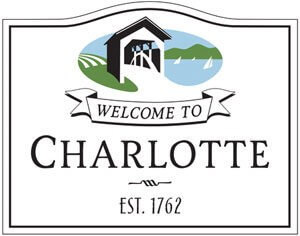Town Plan proceeds
 In a harmonious and productive first public meeting on the Town Plan on Monday, December 11, the Charlotte Selectboard and the town’s assembled citizens reached consensus that the plan would be voted on at Town Meeting, 2018. If the process proceeds as expected, the Planning Commission will incorporate by January 3 the changes to the plan recommended at Monday’s meeting. After that date no further substantive changes can be made in the document prior to the vote. The Selectboard will host a final informational hearing on the amended Plan on January 22.
In a harmonious and productive first public meeting on the Town Plan on Monday, December 11, the Charlotte Selectboard and the town’s assembled citizens reached consensus that the plan would be voted on at Town Meeting, 2018. If the process proceeds as expected, the Planning Commission will incorporate by January 3 the changes to the plan recommended at Monday’s meeting. After that date no further substantive changes can be made in the document prior to the vote. The Selectboard will host a final informational hearing on the amended Plan on January 22.
The suggested changes centered on three main issues: 1) the importance of the 2010 East Charlotte study and discrepancies between two maps each purporting to indicate the boundaries of the East Charlotte Village; 2) inclusion of the much discussed ideas for economic development in Charlotte; and 3) estimation of the funds needed to implement the plan.
Speaking first from the audience, Clark Hinsdale argued that implementing the 2010 E. Charlotte study should be a high priority in the Town Plan, as it would allow landowners to decide how to make use of their properties. He pointed out further that it should be clear in the Plan that the Town has no jurisdiction in the implementation of “standard agricultural practices.”
Mike Russell sent a ripple of laughter through the assembly by suggesting that the section on “Economic Development Strategies” would better be titled “Economic Stagnation” in view of the singular emphasis on agriculture in the plan and the failure to mention any of ideas proposed by citizens to attract non-agricultural businesses to the West Charlotte Village.
Nancy Wood added that people want certain services in the Charlotte, such as a gas station (akin to the Blacksmith she recalls from her early years in Charlotte) and places where they can get together socially. The goal, she suggested, is a vibrant village, not urbanization. In line with this distinction, Isaiah Kiley proposed adding the phrase “and to limit development where significant environmental resources exist or in other areas of high public value” to the current bullet under Vision and Goals “focusing growth in the East and West Villages”.
Fritz Tegatz pointed out that, as currently written, the plan included no funds for implementation and suggested adding a section on what may be needed.
As the meeting wound down, Bill Stuono expressed concern that the goal of obtaining 40 percent of town electricity from renewables by 2020 was overly optimistic. Planning Commission member Marty Illick responded that the energy goals were aspirational and that the Energy Committee was working toward them.
In other business, Town Clerk/Treasurer Mary Mead reviewed likely Town Hall revenues and expenditures as an initial step in creating the FY 18/19 budget. She forecast a slight drop in Town Hall revenue and an increase in expenditures over the current budget, but it is too early in the process to specify this with certainty.
The board also approved a Certificate of Adoption pertaining to the 2017 County All-Hazard Mitigation Plans, which allows FEMA to reimburse the town and its people in case of a natural disaster.

